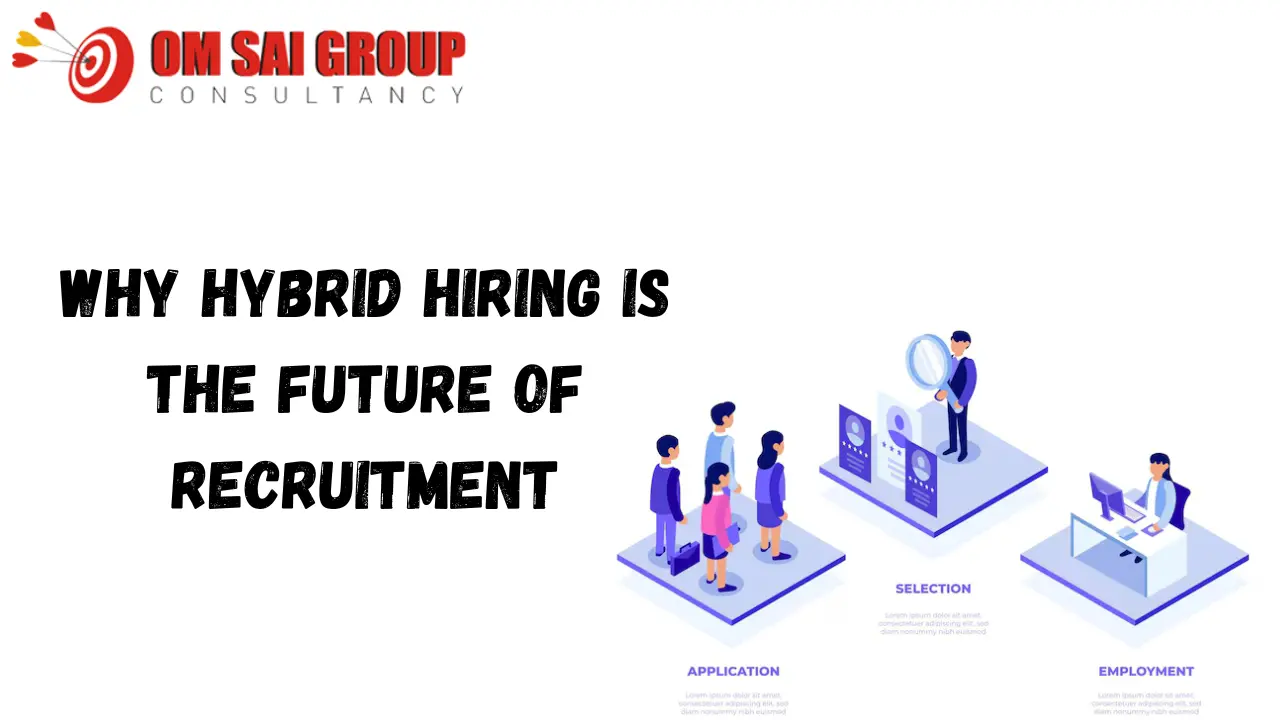
The Future of Talent Acquisition Is Hybrid
Organizations in today’s changing talent market no longer work in the strict structures of past recruitment. They need flexible, scalable, and responsive models to deal with the changing needs of the workforce and the continuously varying demands of industries. Hybrid hiring models This is where the hybrid hiring model comes in as a game-changer. Placement Service
As companies shift toward innovation, boundaries between traditional recruitment methods and online hiring break down. Businesses that adopt hybrid approaches open up agility, broader access to talent, and unrivaled flexibility. Whether you’re working with a multinational team or building out a regional presence, adding the hybrid work model to your talent strategy is not only strategic—it’s critical. Hybrid hiring models
Why Hybrid Hiring Is Gaining Traction
Today’s talent leaders have a complex dilemma to solve: how to hire quicker, smarter, and more inclusively. The hybrid model, a blend of on-premise and remote hiring practices, offers a persuasive answer. Companies are no longer bound by location limits or dependent on in-office interviews alone. By combining in-person testing with virtual screenings, recruitment becomes multidimensional and streamlined. Hybrid hiring models
Firms are using hybrid hiring jobs to connect with a broader talent pool, remove location bias, and streamline hiring timelines. Technology-enabled interviews, asynchronous video screening, and AI-powered shortlisting tools are now usual weapons in the hybrid arsenal. The outcome? Higher candidate satisfaction and streamlined internal processes.
Think about big businesses and startups equal—both increasingly rely on hybrid hiring models in HRM to grow recruitment while preserving quality. From technology organizations to healthcare practitioners, this model closes operational gaps and enables quick team formation.

The Core Benefits of Hybrid Hiring Models
1. Broader Talent Access
Perhaps the most impressive advantage of hybrid hiring is that it can open up global talent. No longer must employers be bound to local markets. This creates opportunities for culturally rich teams, new ideas, and specialized skillsets that may not be present in a given region. Hybrid hiring models
The presence of hybrid job examples such as remote developers, hybrid sales managers, or partially-remote creative leads shows how companies are crafting jobs with flexibility and functionality. Staffing solutions Hybrid recruitment facilitates such flexibility so that employees can work from home but still contribute significantly to team goals.
2. Cost-Effective Operations
Logistics, travel costs, and office infrastructure have a considerable effect on the budget for hiring. Hybrid recruitment minimizes the necessity for large amounts of face-to-face interaction, particularly in the initial stages of hiring. Virtual interviews, document verification, and onboarding processes all contribute to cutting administrative expenses. Hybrid hiring models
Organizations embracing the hybrid recruitment company model tend to experience lower time-to-hire and improved operational effectiveness. Cost savings can be diverted to employer branding or upskilling programs, bolstering the overall recruitment ecosystem.
3. Improved Candidate Experience
Candidates no longer demand merely a salary. They want flexibility, independence, and respect for their time. Hybrid hiring addresses these in ways tailored to their needs—digital applications, online tests, and video meet-and-greets—while not abandoning the human element of face-to-face interactions where required.
Including the hybrid work from home model in job placements adds value to employer attractiveness. Prospective employees are more likely to connect with organizations that exhibit flexibility and understanding when it comes to recruitment. Hybrid hiring models
4. Enhanced Speed and Agility
Empty positions equate to lost productivity. The hybrid model provides quicker hiring timelines by enabling recruiters to interview remotely, minimizing scheduling conflicts and geographical limitations. Automated screening and electronic assessment tools accelerate timelines further.
This faster speed doesn’t sacrifice quality. In fact, companies utilizing hybrid hiring models examples such as early Zoom screens followed by in-person cultural fit evaluations report improved candidate fit and long-term worker retention.
5. Data-Driven Decision Making
Hiring analytics flourish in virtual settings. Hybrid hiring systems gather rich data—application volume, drop-off points, interview results, and time-to-offer data. This information enables hiring teams to optimize strategies, forecast hiring bottlenecks, and enhance success rates. Hybrid hiring models
Leveraging data from hybrid hiring models in HRM, companies can better understand candidate behavior and optimize job listings, selection criteria, and onboarding processes accordingly. manpower Service
6. Scalable and Sustainable

As companies grow, their recruitment strategies must evolve too. Hybrid hiring offers scalability that traditional methods often cannot. Whether hiring five employees or five hundred, the model remains consistent and efficient. Hybrid hiring models
Additionally, hybrid strategies are environmentally friendly. Fewer face-to-face interviews result in less travel and carbon emissions—a top priority for today’s socially aware companies.
How Businesses Are Adapting to the Hybrid Hiring Paradigm
Innovative companies are already making strides in hybrid hiring. Amazon, for instance, uses virtual career fairs and video interviews as elements of its scalable recruitment engine. Mid-sized companies and startups, on the other hand, are getting into partnerships with hybrid recruitment agencies to establish agile recruitment pipelines combining face-to-face and digital approaches. Hybrid hiring models
The need for skilled workers proficient in remote work technology, cross-functional communications, and self-management has grown. This trend is consistent with the rising number of hybrid recruitment opportunities posted on large job boards where positions are designed to allow flexible work arrangements.
Individuals also seek ways to enhance hybrid recruitment effectiveness, remote onboarding best practices, and technologies that enable smooth digital collaboration. These trends all point to the need for organizations to rethink their hiring infrastructure. Hybrid hiring models
Challenges in Hybrid Hiring—And How to Overcome Them
Although the advantages are significant, the hybrid approach is not simple. Coordinating virtual and physical processes at the same time requires coordination, transparency, and sound technology infrastructure.
Some of the challenges include:
- Communication breakdowns during virtual interviews
- Technical glitches during online tests
- Cultural mismatch in remote teams
- Absence of candidate feedback in real-time
The solution is to be proactive planning—digital interview guidelines, virtual onboarding structures, and hybrid-compatible job postings are a must. Educating hiring managers to move around these spaces is just as critical. Hybrid hiring models
ATS (Applicant Tracking Systems), virtual workplace software, and AI-driven recruiting analytics are tools that can reduce these challenges and simplify hybrid processes.
Real-World Success Stories
A top Bangalore SaaS organization adopted a hybrid hiring approach in a phase of aggressive scaling. Coupling video tests with individual last rounds at their local office, they lowered their average time-to-hire from 36 to 19 days. Their candidate drop-off rate also fell by 27%, and employee engagement improved after onboarding. Hybrid hiring models
An MNC with headquarters in the US saw its India operation shift to hybrid hiring for jobs in digital marketing and IT support. They recruited through virtual career fairs and applied structured online assignments for assessment. The outcome? Accelerated onboarding, better diversity ratios, and 22% less recruitment expense in two quarters.
The Road Ahead: Actionable Steps for Organizations
For organizations to maximize the hybrid hiring model, they need to:
- Review current recruitment procedures to determine steps that can be automated or combined with face-to-face steps.
- Invest in technology tools that enable remote interviewing, document handling, and collaborative team work.
- Educate HR staff on managing the hybrid interactions successfully and with sensitivity.
- Tailor roles to fit hybrid job templates, while ensuring flexibility without role ambiguity.
- Monitor performance metrics on a regular basis and adjust the hybrid strategy based on insights from data. Hybrid hiring models
Conclusion: Embrace the Hybrid Advantage
The hybrid hire model is not a trend—it’s a revolution. It is in line with workforce sentiment, operational efficiency, and the future of work itself. Companies that embrace this model are not only maximizing their hiring efforts but also positioning themselves as innovative employers of choice. Recruitment Agencies
Whether you’re constructing remote-first organizations or developing flexible workplace culture, hybrid hiring models are the foundation for confident growth. With the growth of hybrid recruitment jobs and hybrid work from home mainstreaming, it’s time to evolve.
Individuals also look for functional frameworks, measures of success, and role-level hybrid hiring strategies—because this is no longer a future of recruitment. It’s present.
FAQ
What is an example of a hybrid job?
A hybrid job combines working remotely with days spent in a physical office. An example is a Marketing Manager who works from home three days a week to focus on campaign strategy and content creation, then comes into the office two days a week for team meetings, collaborative brainstorming sessions, and client presentations. This allows for both focused individual work and in-person team synergy. Hybrid hiring models
What is HR for hybrid wariring?
HR for hybrid working involves adapting human resources practices to support a workforce that splits time between the office and remote locations. This includes developing clear policies, fostering inclusive communication and culture, managing performance fairly across different settings, ensuring employee well-being, leveraging technology for collaboration, and addressing potential inequalities between in-office and remote staff. Its goal is to create a productive and engaged workforce in this evolving model. Hybrid hiring models
What is an example of a hybrid model?
A common example of a hybrid model is the hybrid work model, where employees split their time between working remotely (e.g., from home) and working in a physical office. Hybrid hiring models This combines the flexibility and autonomy of remote work with the collaboration and in-person connection of traditional office environments. Many companies adopt variations, like fixed days in the office or flexible schedules chosen by employees.
What is a hybrid business model?
A hybrid business model combines elements from two or more different business strategies to leverage their respective strengths. This often means blending online and physical operations (like a “brick-and-click” retailer) or mixing various revenue streams (e.g., sales, subscriptions, and advertising). Hybrid hiring models The goal is to enhance flexibility, reach a wider customer base, and improve efficiency.

